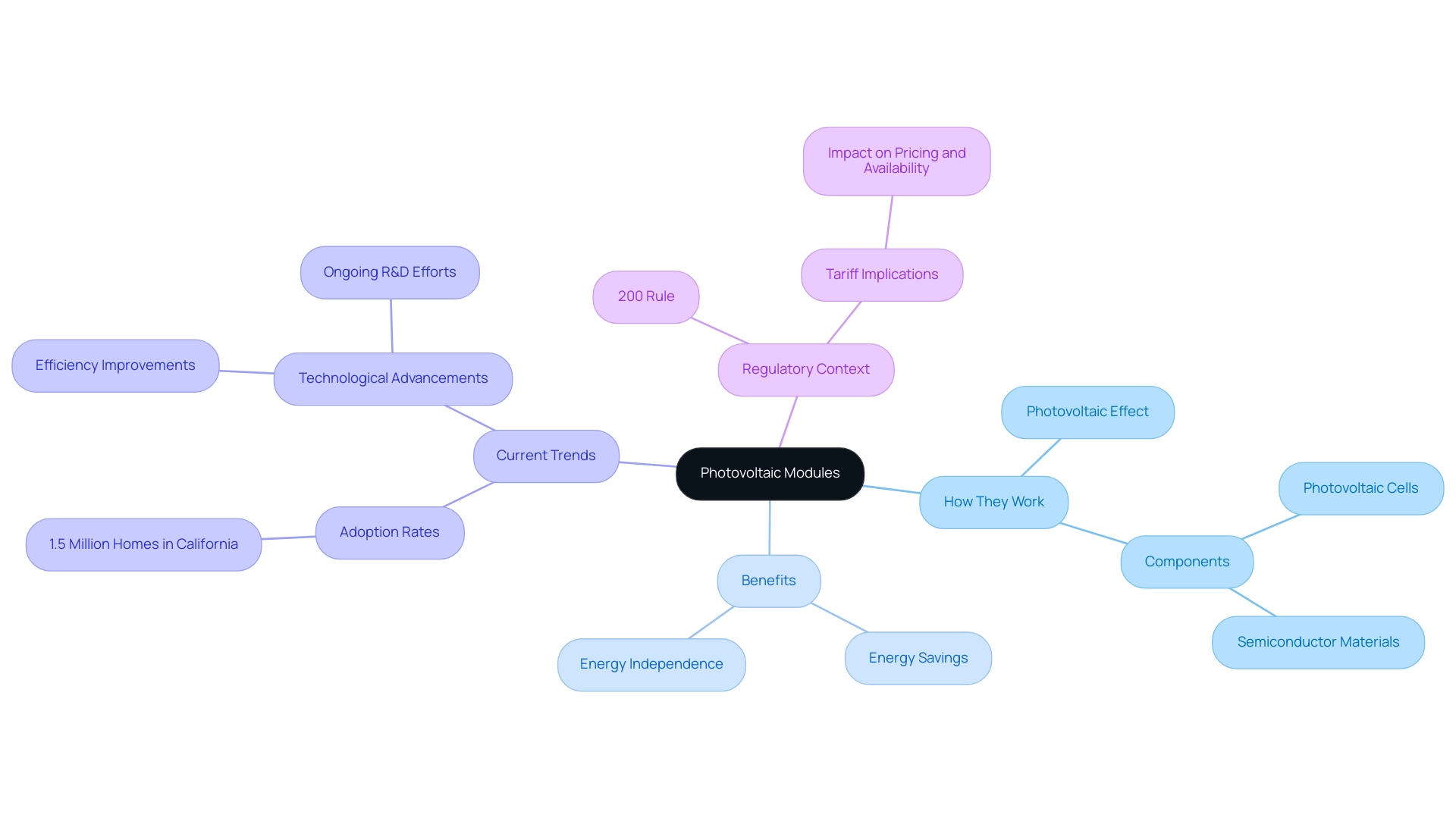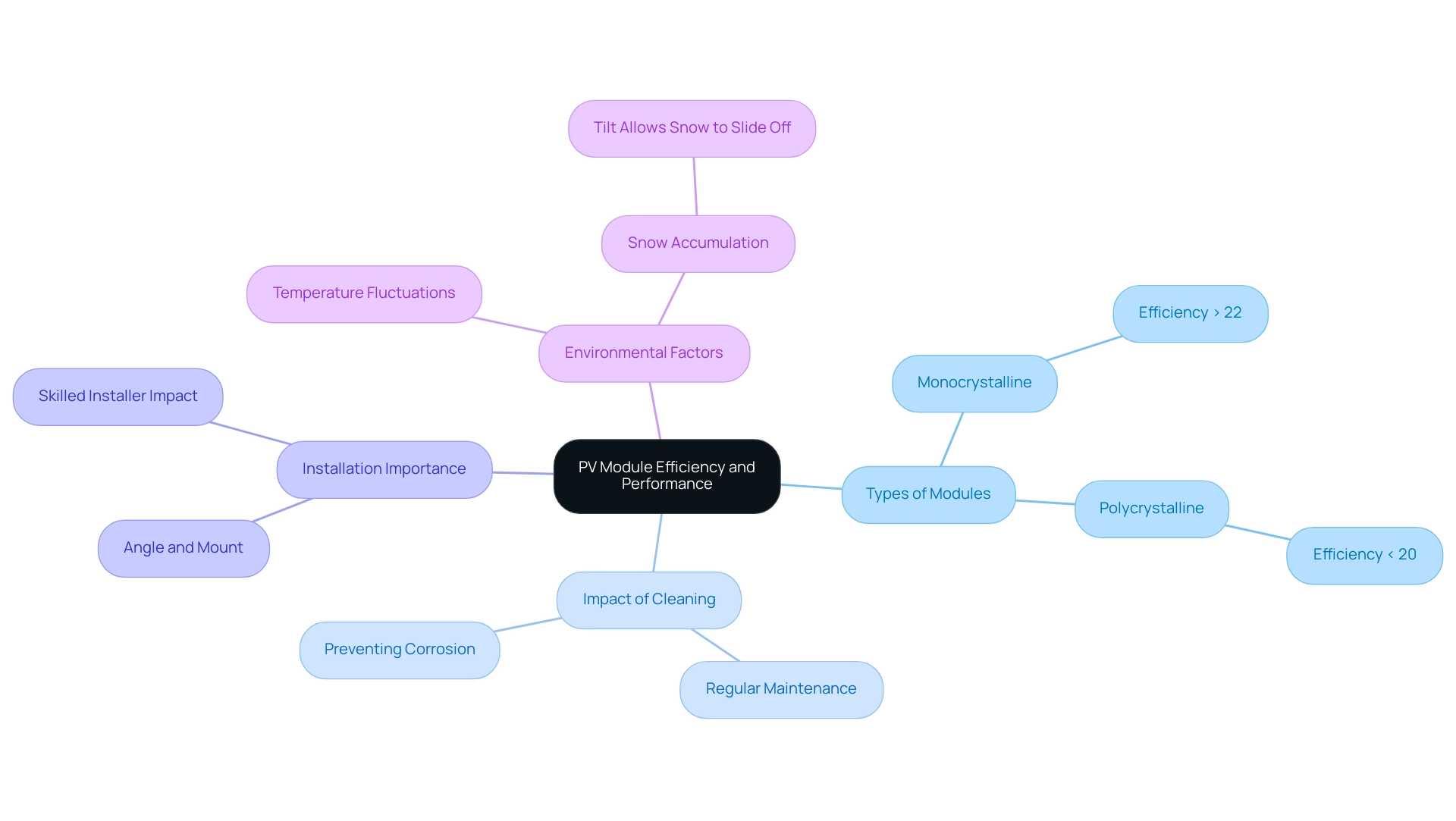Overview
We understand that rising energy bills can be a source of stress for many homeowners. Photovoltaic (PV) modules, which convert sunlight into electricity through the photovoltaic effect, offer a meaningful solution. These devices consist of multiple semiconductor-based cells that generate direct current (DC) electricity when exposed to sunlight, empowering you to take control of your energy needs. Imagine the peace of mind that comes with energy independence and reduced utility costs.
As more and more homeowners embrace solar energy, advancements in technology have improved module efficiency and performance, making this sustainable solution more accessible than ever. Together, we can navigate this journey towards a more sustainable future. If you’re curious about how PV modules can benefit your home, let’s work towards making your energy goals a reality.
Introduction
Are you feeling overwhelmed by rising energy bills? The rise of solar energy is transforming how homeowners like you approach electricity consumption. At the forefront of this revolution are photovoltaic modules, commonly known as solar panels. These remarkable devices harness sunlight, converting it into clean, renewable energy that empowers you to reduce your reliance on traditional power sources.
As the demand for sustainable energy solutions grows—especially in states like California—it’s essential to understand the intricacies of solar technology, from module efficiency to installation processes. We understand that navigating these options can be daunting, but with advancements in photovoltaic technology leading to improved efficiency and significant cost savings, many homeowners are discovering the joys of energy independence.
This article delves into the fundamentals of photovoltaic modules, exploring their types, performance, financial incentives, and the crucial steps for successful installation. Together, we can embrace sustainability and responsible recycling practices, ensuring a brighter future for all.
Defining Photovoltaic Modules: The Basics of Solar Technology
Photovoltaic modules, often referred to as solar collectors, are essential devices that transform sunlight into electricity through the photovoltaic effect. Understanding what a PV module is and its advantages under the 200% Rule is crucial for residents seeking to reduce their energy bills. Each module consists of numerous photovoltaic cells, primarily made from semiconductor materials like silicon. When sunlight strikes these cells, it excites electrons, generating direct current (DC) electricity.
This groundbreaking technology empowers homeowners to lessen their reliance on traditional power sources and actively participate in promoting a sustainable future.
In California, the adoption of photovoltaic panels has surged, with approximately 1.5 million homes utilizing renewable systems as of 2025. This trend reflects a growing awareness of the benefits of photovoltaic technology, including significant reductions in utility expenses and enhanced energy independence. For instance, residential photovoltaic installations not only lower monthly utility costs but also provide a safeguard against rising electricity prices, which have increased nearly 20% over the last five years.
Notably, photovoltaic plants dominated renewable Power Purchase Agreements (PPAs) with a share of almost 70% in 2023, underscoring the technology’s vital role in the renewable energy landscape.
Recent advancements in photovoltaic technology have led to remarkable improvements in PV module efficiency, with some products achieving efficiencies exceeding 22%. Ongoing research and development efforts are focused on enhancing performance and reducing costs. Additionally, the U.S. renewable energy market is navigating changes due to tariff implications, with nearly 15.4 GW of modules imported in Q3 2024 and over 9.4 GW of cells imported, accounting for 75% of the tariff-rate quota.
This highlights the dynamic nature of the industry, particularly in understanding what a PV module is and the challenges it faces.
Real-world examples of photovoltaic installations illustrate their effectiveness. A recent case analysis highlighted a California resident who established a renewable power system that not only met their energy needs but also allowed them to sell surplus electricity back to the grid, further enhancing their power autonomy. Moreover, the case study titled ‘U.S. PV Imports and Tariff Implications’ illustrates how tariffs are influencing the pricing and availability of photovoltaic systems, which is critical for residents considering renewable investments.
As we move through 2025, the significance of photovoltaic systems in achieving energy independence cannot be overstated. With an increasing number of residents embracing photovoltaic technology, the shift towards sustainable practices is becoming more apparent, paving the way for a cleaner, more resilient energy future. Powercore Electric stands as your trusted panel supplier in Northern California, committed to advancing sustainable power solutions and assisting you in managing your energy future.
The 200% Rule allows homeowners to install systems capable of producing up to 200% of their annual consumption, facilitating the offset of future energy needs and reducing dependence on the grid. As Inemesit Ukpanah observes, ‘The shift to solar power is not merely a trend; it is an essential move towards independence and sustainability for future generations.
Types of PV Modules: Monocrystalline vs. Polycrystalline
Understanding what a PV module is can be essential for homeowners concerned about rising energy bills. Primarily, these modules are categorized into two types: monocrystalline and polycrystalline. Monocrystalline modules, crafted from a single crystal structure, are well-known for their superior efficiency rates, typically ranging from 15% to 22%. This efficiency is especially beneficial in low-light situations, making them a favored option for eco-conscious homeowners seeking reliable power generation and significant savings on utility expenses.
Additionally, their sleek black appearance and longer lifespan—often exceeding 25 years—promote sustainability while reducing dependence on the grid. In contrast, polycrystalline modules consist of multiple silicon crystals, resulting in a lower efficiency range of approximately 13% to 16%. While these panels are generally more affordable, their efficiency disadvantage means they may require more installation space to produce the same amount of power as their monocrystalline counterparts. This consideration is crucial for property owners with limited roof space or specific aesthetic preferences.
The market for monocrystalline photovoltaic cells is projected to experience substantial growth, with estimates indicating an increase from over USD 6.6 billion in 2024 to USD 18.9 billion by 2037, reflecting a compound annual growth rate (CAGR) of 8.6%. This trend is propelled by the increasing need for self-sufficiency in power among property owners and the investment in utility-scale photovoltaic projects, where monocrystalline cells are preferred for their efficiency and reliability. A recent case study highlights that the demand for monocrystalline photovoltaic cells is significantly driven by residential installations, as property owners aim to embrace sustainability while utilities invest in large-scale renewable energy farms to meet energy needs.
Real-life examples illustrate this trend, as many homeowners are increasingly opting for monocrystalline systems to maximize their energy output and minimize their carbon footprint. However, it’s essential to weigh the advantages of both types. While monocrystalline panels excel in efficiency and longevity, polycrystalline panels may appeal to those with budget constraints or larger installation areas.
For homeowners, understanding what a PV module is and how these panels function is crucial. What is a PV module? It is a device that transforms sunlight into electricity via the photovoltaic effect, where cells produce direct current (DC) electricity that is subsequently converted to alternating current (AC) by an inverter for residential use. Choosing the appropriate inverter and battery backup is vital for ensuring dependable power during outages and harsh weather conditions.
Regular panel maintenance, including cleaning and inspections, is essential for maximizing efficiency and longevity. Innovative cleaning solutions, such as automated cleaning systems, can help maintain optimal performance.
However, it is also vital to consider the environmental downsides of photovoltaic technology, including impacts on biodiversity, habitat loss, resource consumption, and disposal issues, to maintain a balanced perspective on renewable power solutions. As Aditi Shivarkar observes, grasping these complexities is essential for making informed decisions in the changing power landscape. Together, we can navigate these challenges and work towards a sustainable energy future.
Understanding PV Module Efficiency and Performance
The efficiency of a photovoltaic (PV) module is a critical metric, helping to clarify how much sunlight is converted into usable electricity. We understand that many homeowners are concerned about rising energy bills, and it’s reassuring to know that in 2025, average efficiency ratings for solar systems have improved significantly, with many high-quality models achieving efficiencies above 20%. Monocrystalline panels, recognized for their exceptional performance, frequently surpass 22% efficiency, making them a preferred choice for those seeking optimal power generation.
Regular professional cleaning significantly enhances this efficiency. Cleaner surfaces absorb more sunlight, directly impacting energy output and reducing reliance on grid energy, which can increase carbon footprints. This cleaning process also prevents corrosion and buildup, which can hinder performance over time, ensuring that you get the most out of your investment.
It’s common to wonder about the various elements affecting the effectiveness of photovoltaic modules, such as the type of photovoltaic cells, temperature fluctuations, and environmental conditions. For instance, while monocrystalline modules generally outperform polycrystalline options, the installation angle and orientation play a pivotal role in optimizing energy capture. As Tom Beresnyak, a Pennsylvania State University extension educator, notes, ‘The installer can make a huge difference because the angle and the mount are important for maximizing what you have at that location — a skilled installer is still going to be the real key in your long-term production.’ This highlights the importance of professional installation and regular maintenance, including expert cleaning, in enhancing the long-term performance and lifespan of your solar system.
Moreover, regular maintenance and monitoring are essential for sustaining optimal performance throughout the lifespan of the system. Professional cleaning can help prevent corrosion and buildup on surfaces, ensuring they function at peak efficiency. By committing to regular cleaning, you can not only maintain energy production but also reduce your reliance on grid energy, further promoting energy independence.
Homeowners should also be aware that solar systems are rigorously tested under extreme conditions, ensuring reliability even in adverse weather. For instance, while snow accumulation can temporarily hinder performance, the angle of the surfaces allows snow to slide off, enabling continued electricity generation.
Real-world examples illustrate the importance of efficiency ratings. A recent case study emphasized that property owners who chose modules with efficiency ratings exceeding 20% not only optimized their power output but also realized substantial savings on their electricity expenses. By understanding these factors and choosing the right PV modules, you can effectively transition to sustainable energy practices and enhance your energy independence through regular professional cleaning and maintenance. Together, we can work towards a more sustainable future.
Sustainability and Recycling: Managing the Life Cycle of PV Modules
To understand what a PV module is, it’s important to consider its life cycle, which includes several critical stages:
- Manufacturing
- Installation
- Operation
- End-of-life management
We understand that sustainable methods during the production stage are crucial for reducing the carbon footprint associated with photovoltaic systems. Given that these modules typically have an operational lifespan of 25 to 30 years, the management of their end-of-life becomes increasingly significant.
Recycling PV modules is essential for reclaiming valuable materials like silicon, silver, and glass, which can be repurposed into new products. As we reflect on our energy habits, it’s heartening to see recent advancements in the photovoltaic module recycling sector that emphasize a growing commitment to sustainability. For instance, the market for photovoltaic recycling is projected to rise from USD 1.87 billion in 2024 to an impressive USD 118.54 billion by 2037, indicating a compound annual growth rate (CAGR) exceeding 37.6%. Notably, the Asia Pacific region is expected to hold the largest revenue share of 38% by 2037 in this industry, showcasing a significant shift towards responsible waste management practices.
This growth is driven by increasing awareness of a PV module’s environmental impact during manufacturing and the urgent need for responsible waste management, especially considering concerns about the sustainability of these systems due to their material composition. Various recycling methods, including mechanical and chemical processes, have been developed to effectively mitigate waste and reduce environmental impact. It’s common to feel overwhelmed by these issues, but significant steps are being taken. For example, in July 2023, Marubeni Corporation and HAMADA Co. Ltd introduced innovative reuse and recycling services for used energy modules, followed by GSG Recovery’s comparable initiatives in August 2023. These examples highlight a meaningful trend towards sustainable practices within the industry and illustrate the importance of recycling methods in managing panel waste.
As property owners consider installation, it is crucial to inquire about recycling options to ensure responsible end-of-life management. By emphasizing sustainability in both the production and recycling stages, we can aid in creating a cleaner environment while enjoying the benefits of renewable power. As Inemesit Ukpanah, a seasoned content writer, emphasizes, understanding the lifecycle and sustainability practices in the energy sector is essential for making informed decisions. Together, we can work towards a more sustainable future.
Financial Considerations: Incentives and Savings with PV Modules
Investing in a PV module can provide environmentally conscious residents with significant financial advantages over time, particularly when comparing the costs of renewable sources to traditional electricity. One of the most impactful incentives is the Residential Clean Energy Credit, which allows for a 30% deduction on installation costs, significantly reducing the initial investment. Additionally, various state and local authorities offer incentives that further lower these initial costs, making renewable energy more attainable and appealing.
The potential savings are truly remarkable. For instance, homeowners in California can expect to save around $138,716.35 over the lifespan of a 7.2 kW power system, which typically lasts 25 years. This is especially noteworthy in light of the projected rise in electricity prices in the U.S., which have increased by approximately 3% annually over the past decade. Therefore, transitioning to renewable energy not only addresses rising expenses but also presents a financially viable solution.
As Jeremy Pearl points out, “most families in California spend more than $1,700 on electricity each year!” This statistic underscores the importance of considering solar power as a practical option for reducing utility costs. Real-world examples vividly illustrate these savings; larger households, which naturally consume more electricity, can enjoy even greater benefits from renewable energy installations.
Moreover, affluent areas in Los Angeles, known for higher energy consumption, could experience substantial savings by embracing renewable solutions. However, it’s essential for property owners to carefully navigate the financial terms of renewable energy agreements, as unfavorable conditions could undermine potential savings.
In addition to renewable energy, residents should also consider the costs associated with Level 2 home chargers for electric vehicles. The average installation cost for a Level 2 charger ranges from $500 to $2,000, depending on the complexity of the installation and local regulations. This upfront investment can be offset by the long-term savings on fuel costs, as electric vehicles generally cost less to operate than traditional gasoline vehicles.
Collaborating with reputable energy providers can further enhance the investment experience. Services like EnergySage pre-screen energy companies to ensure high-quality installations and evaluate them based on reputation and responsiveness, helping property owners make informed choices.
Additionally, government initiatives, including the Federal Tax Credit for Electric Vehicles and various state incentives, can assist residents in their transition to renewable energy and electric vehicle charging options. These programs not only reduce the total installation costs but also encourage the adoption of renewable technologies.
In conclusion, understanding what a PV module is, along with these financial incentives and savings opportunities, is crucial for property owners looking to maximize their investment in renewable energy and electric vehicle charging options. With a strategic approach, investing in PV modules promotes energy independence and results in significant long-term financial and ecological benefits, including enhanced EV charging solutions and the integration of effective renewable technologies.
Installing PV Modules: What Homeowners Need to Know
We understand that navigating the process of installing a photovoltaic (PV) module can feel overwhelming. The journey begins with a comprehensive site evaluation, where homeowners assess their energy needs and the suitability of their roofs for solar installation. This crucial step helps identify the best positioning and arrangement of the units, ensuring maximum energy production.
Once the site assessment is complete, obtaining the necessary permits is the next important step. This ensures compliance with local regulations, which can vary significantly across California. While homeowners may technically set up their own energy collectors, it’s essential to recognize that many warranties and local regulations require professional installation to guarantee safety and efficiency.
At Powercore Electric, we emphasize the importance of involving skilled contractors who understand the specific electrical requirements of California communities. This guarantees tailored solutions that function effectively within each unique area.
During installation, several critical factors must be considered. Proper wiring, grounding, and orientation of the units are vital for enhancing efficiency. For example, it’s important to know that popular photovoltaic panels available in 2024 can produce approximately 400 watts of electricity in full sunlight. Therefore, correct installation is key to achieving optimal performance.
Our commitment to unparalleled quality craftsmanship ensures that each installation adheres to the highest standards of safety and efficiency, prioritizing your project from start to finish.
Moreover, as you choose a provider for your energy solutions, it’s wise to consider long-term maintenance requirements and warranties. Hiring a reputable contractor is crucial; with over 2,000 companies in California, comparing estimates and checking customer reviews is essential to ensure quality service. A well-selected contractor not only facilitates a successful installation but also offers ongoing support, which is vital for the longevity of your energy system.
Real-world experiences reinforce the importance of professional installation. Homeowners who conduct thorough research and select qualified contractors report higher satisfaction rates and better performance from their energy systems. As Jeni R., a verified customer, shared, “EnergySage saved me a ton of money by helping me get bids that were half the cost of the bids I got myself by calling around. I can’t say enough good about this organization. Don’t invest in renewable energy without it!” This highlights the value of comparing bids and choosing a qualified contractor.
Furthermore, California residents can benefit from various incentives for renewable systems, including a 30% federal tax credit, property tax exclusions, and sales tax exemptions for such installations. Additionally, investing in battery systems can enhance power storage and efficiency, allowing residents to optimize their renewable sources even on cloudy days. By prioritizing expert guidance and professional installation, property owners can confidently transition to sustainable practices, ensuring their investment yields significant returns in savings and reliability.
With Powercore Electric’s customer-first approach, eco-conscious homeowners can trust that their solar energy journey will be seamless and beneficial for both their wallets and the planet. Together, we can work towards a brighter, more sustainable future.
Conclusion
Embracing solar energy through the installation of photovoltaic modules is a transformative step towards achieving energy independence and fostering a sustainable future. We understand that many homeowners are concerned about rising energy bills, and this article has explored the fundamentals of solar technology, including the mechanics of PV modules, the differences between monocrystalline and polycrystalline panels, and the importance of efficiency and performance. With these insights, homeowners are now better equipped to maximize their energy production while navigating the financial incentives that make solar installations more accessible.
The significance of sustainable practices extends beyond installation; it encompasses the entire lifecycle of solar panels, from responsible manufacturing to effective recycling methods. It’s common to feel uncertain about the environmental impact of our choices, but as the market for solar panel recycling continues to grow, homeowners can take pride in knowing their decisions contribute to a cleaner environment. Furthermore, understanding the financial benefits, such as substantial savings on energy bills and tax incentives, underscores the practicality of investing in solar technology.
In conclusion, the shift towards solar energy is not merely a trend; it is a necessary evolution in how homeowners approach energy consumption. By prioritizing informed decisions and professional installations, individuals can harness the power of the sun to secure long-term savings and promote environmental stewardship. Together we can lead the charge towards a more sustainable and economically sound tomorrow. The future of energy is bright, and with solar technology at the forefront, we invite you to explore how you can make a meaningful impact.








